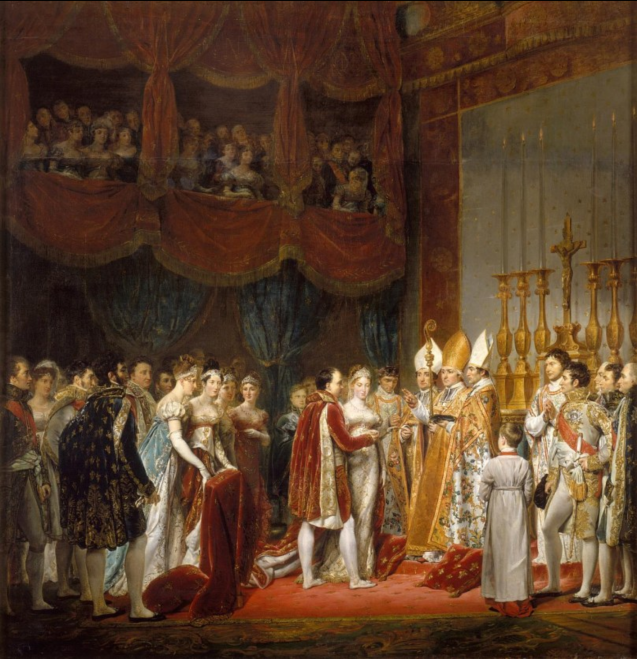Napoleon I and Marie-Louise of Austria were married before God in a ‘chapel’ created by architects Percier and Fontaine out of the Salon Carré at the Louvre on 2 April, 1810. The wedding procession and cortege had to walk all the way from the Tuileries palace, down a great part of the Grande Galerie in order to reach this large space usually given over the exhibition of paintings. We know from Fontaine’s Journal that the director of the Louvre, Vivant Denon, had been opposed to removal of the very large paintings in that gallery in order to make way for the two-level tribunes which were to be built to accommodate the congregation. On hearing of this intransigence however, the emperor, “with animosity, gave the order for the paintings to be removed, and as for any which could not be removed, they should be burned”! The threat was effective and the Salon Carré was emptied of its masterpieces and the tribunes built; an altar was furthermore erected facing the entrance to the gallery, topped with a large cross and six chased vermeil candlesticks made by Odiot – the walls were draped with gold embroidered hangings.
The painter, George Rouget, has here given an accurate representation of the transformed Salon Carré. The moment chosen is that of the nuptial blessing pronounced by Cardinal Fesch over the imperial couple, surrounded as they are by princes, princesses and Court dignitaries. The reference is obviously to David’s Sacre, a painting on Rouget had also collaborated. Indeed, there is an identical solemnity, but through his concentration of the scene on a smaller group of people, arranged around an altar bathed in celestial light, the artist has achieved an atmosphere of extreme intimacy, totally unlike the feel of the massive painting of the Notre-Dame consecration and coronation. There is at the same time however a sense of monumentality, and the emphasis on the height of the building gives the impression that the Salon Carré is in fact a church. The bipartite arrangement of the composition, juxtaposing the dark and empty upper space with the full and luminous lower section accentuates the sense of majesty in this painting designed to celebrate a union which in itself represented the future of the Empire.
In 1835, Louis-Philippe was to order a replica of this picture for the Galeries Historiques in the palace at Versailles, though this later version contains a different viewpoint and numerous variants.
Karine Huguenaud (tr. P.H.)
March 2010


